|
|
|
Mutualistic NetworksJordi Bascompte & Pedro Jordano
Monographs In Population Biology, Vol. 53
Princeton University Press
2013
"Mutualistic interactions among plants and animals have played a paramount role in shaping biodiversity. Yet the majority of studies on mutualistic interactions have involved only a few species, as opposed to broader mutual connections between communities of organisms. Mutualistic Networks is the first book to comprehensively explore this burgeoning field. Integrating different approaches, from the statistical description of network structures to the development of new analytical frameworks, Jordi Bascompte and Pedro Jordano describe the architecture of these mutualistic networks and show their importance for the robustness of biodiversity and the coevolutionary process. Making a case for why we should care about mutualisms and their complex networks, this book offers a new perspective on the study and synthesis of this growing area for ecologists and evolutionary biologists. It will serve as the standard reference for all future work on mutualistic interactions in biological communities."
|
Buy from amazon.co.uk 
|
|
Ecology of Climate Change: The Importance of Biotic InteractionsEric Post
Monographs In Population Biology, Vol. 52
Princeton University Press
2013
"Rising temperatures are affecting organisms in all of Earth's biomes, but the complexity of ecological responses to climate change has hampered the development of a conceptually unified treatment of them. In a remarkably comprehensive synthesis, this book presents past, ongoing, and future ecological responses to climate change in the context of two simplifying hypotheses, facilitation and interference, arguing that biotic interactions may be the primary driver of ecological responses to climate change across all levels of biological organization. Eric Post's synthesis and analyses of ecological consequences of climate change extend from the Late Pleistocene to the present, and through the next century of projected warming. His investigation is grounded in classic themes of enduring interest in ecology, but developed around novel conceptual and mathematical models of observed and predicted dynamics. Using stability theory as a recurring theme, Post argues that the magnitude of climatic variability may be just as important as the magnitude and direction of change in determining whether populations, communities, and species persist. He urges a more refined consideration of species interactions, emphasizing important distinctions between lateral and vertical interactions and their disparate roles in shaping responses of populations, communities, and ecosystems to climate change."
|
Buy from amazon.co.uk 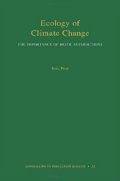
|
|
Population and Community Ecology of Ontogenetic DevelopmentAndre M. De Roos and Lennart Persson
Monographs In Population Biology, Vol. 51
Princeton University Press
2012
"Most organisms show substantial changes in size or morphology after they become independent of their parents and have to find their own food. Furthermore, the rate at which these changes occur generally depends on the amount of food they ingest. In this book, André de Roos and Lennart Persson advance a synthetic and individual-based theory of the effects of this plastic ontogenetic development on the dynamics of populations and communities. De Roos and Persson show how the effects of ontogenetic development on ecological dynamics critically depend on the efficiency with which differently sized individuals convert food into new biomass. Differences in this efficiency - or ontogenetic asymmetry - lead to bottlenecks in and thus population regulation by either maturation or reproduction. De Roos and Persson investigate the community consequences of these bottlenecks for trophic configurations that vary in the number and type of interacting species and in the degree of ontogenetic niche shifts exhibited by their individuals. They also demonstrate how insights into the effects of maturation and reproduction limitation on community equilibrium carry over to the dynamics of size-structured populations and give rise to different types of cohort-driven cycles. Featuring numerous examples and tests of modeling predictions, this book provides a pioneering and extensive theoretical and empirical treatment of the ecology of ontogenetic growth and development in organisms, emphasizing the importance of an individual-based perspective for understanding population and community dynamics."
|
Buy from amazon.co.uk 
|
|
Food WebsKevin S. McCann
Monographs In Population Biology, Vol. 50
Princeton University Press
2011
"Human impacts are dramatically altering our natural ecosystems but the exact repercussions on ecological sustainability and function remain unclear. As a result, food web theory has experienced a proliferation of research seeking to address these critical areas. Arguing that the various recent and classical food web theories can be looked at collectively and in a highly consistent and testable way, Food Webs synthesizes and reconciles modern and classical perspectives into a general unified theory. Kevin McCann brings together outcomes from population-, community-, and ecosystem-level approaches under the common currency of energy or material fluxes. He shows that these approaches - often studied in isolation - all have the same general implications in terms of population dynamic stability. Specifically, increased fluxes of energy or material tend to destabilize populations, communities, and whole ecosystems. With this understanding, stabilizing structures at different levels of the ecological hierarchy can be identified and any population-, community-, or ecosystem-level structures that mute energy or material flow also stabilize systems dynamics. McCann uses this powerful general framework to discuss the effects of human impact on the stability and sustainability of ecological systems, and he demonstrates that there is clear empirical evidence that the structures supporting ecological systems have been dangerously eroded. Uniting the latest research on food webs with classical theories, this book will be a standard source in the understanding of natural food web functions."
|
Buy from amazon.co.uk 
|
|
Ecological Niches and Geographic DistributionsA. Townsend Peterson, Jorge Soberón, Richard G. Pearson, Robert P. Anderson, Enrique Martínez-Meyer, Miguel Nakamura & Miguel B. Araújo
Monographs In Population Biology, Vol. 49
Princeton University Press
2011
"This book provides a first synthetic view of an emerging area of ecology and biogeography, linking individual- and population-level processes to geographic distributions and biodiversity patterns. Problems in evolutionary ecology, macroecology, and biogeography are illuminated by this integrative view. The book focuses on correlative approaches known as ecological niche modeling, species distribution modeling, or habitat suitability modeling, which use associations between known occurrences of species and environmental variables to identify environmental conditions under which populations can be maintained. The spatial distribution of environments suitable for the species can then be estimated: a potential distribution for the species. This approach has broad applicability to ecology, evolution, biogeography, and conservation biology, as well as to understanding the geographic potential of invasive species and infectious diseases, and the biological implications of climate change. The authors lay out conceptual foundations and general principles for understanding and interpreting species distributions with respect to geography and environment. Focus is on development of niche models. While serving as a guide for students and researchers, the book also provides a theoretical framework to support future progress in the field."
|
Buy from amazon.co.uk 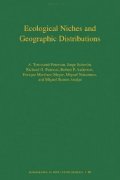
|
|
Adaptive DiversificationMichael Doebeli
Monographs In Population Biology, Vol. 48
Princeton University Press
2010
"Understanding the mechanisms driving biological diversity remains a central problem in ecology and evolutionary biology. Traditional explanations assume that differences in selection pressures lead to different adaptations in geographically separated locations. This book takes a different approach and explores adaptive diversification - diversification rooted in ecological interactions and frequency-dependent selection. In any ecosystem, birth and death rates of individuals are affected by interactions with other individuals. What is an advantageous phenotype therefore depends on the phenotype of other individuals, and it may often be best to be ecologically different from the majority phenotype. Such rare-type advantage is a hallmark of frequency-dependent selection and opens the scope for processes of diversification that require ecological contact rather than geographical isolation. Michael Doebeli investigates adaptive diversification using the mathematical framework of adaptive dynamics. Evolutionary branching is a paradigmatic feature of adaptive dynamics that serves as a basic metaphor for adaptive diversification, and Doebeli explores the scope of evolutionary branching in many different ecological scenarios, including models of coevolution, cooperation, and cultural evolution. He also uses alternative modeling approaches. Stochastic, individual-based models are particularly useful for studying adaptive speciation in sexual populations, and partial differential equation models confirm the pervasiveness of adaptive diversification. Showing that frequency-dependent interactions are an important driver of biological diversity, Adaptive Diversification provides a comprehensive theoretical treatment of adaptive diversification."
|
Buy from amazon.co.uk 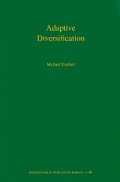
|
|
Resolving Ecosystem ComplexityOswald J. Schmitz
Monographs In Population Biology, Vol. 47
Princeton University Press
2010
"An ecosystem's complexity develops from the vast numbers of species interacting in ecological communities. The nature of these interactions, in turn, depends on environmental context. How do these components together influence an ecosystem's behavior as a whole? Can ecologists resolve an ecosystem's complexity in order to predict its response to disturbances? Resolving Ecosystem Complexity develops a framework for anticipating the ways environmental context determines the functioning of ecosystems. Oswald Schmitz addresses the critical questions of contemporary ecology: How should an ecosystem be conceptualized to blend its biotic and biophysical components? How should evolutionary ecological principles be used to derive an operational understanding of complex, adaptive ecosystems? How should the relationship between the functional biotic diversity of ecosystems and their properties be understood? Schmitz begins with the universal concept that ecosystems are comprised of species that consume resources and which are then resources for other consumers. From this, he deduces a fundamental rule or evolutionary ecological mechanism for explaining context dependency: individuals within a species trade off foraging gains against the risk of being consumed by predators. Through empirical examples, Schmitz illustrates how species use evolutionary ecological strategies to negotiate a predator-eat-predator world, and he suggests that the implications of species trade-offs are critical to making ecology a predictive science. Bridging the traditional divides between individuals, populations, and communities in ecology, Resolving Ecosystem Complexity builds a systematic foundation for thinking about natural systems."
|
Buy from amazon.co.uk 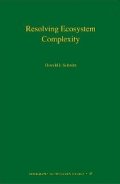
|
|
From Populations to Ecosystems: Theoretical Foundations for a New Ecological SynthesisMichel Loreau
Monographs In Population Biology, Vol. 46
Princeton University Press
2010
"The major subdisciplines of ecology - population ecology, community ecology, ecosystem ecology, and evolutionary ecology - have diverged increasingly in recent decades. What is critically needed today is an integrated, real-world approach to ecology that reflects the interdependency of biodiversity and ecosystem functioning. From Populations to Ecosystems proposes an innovative theoretical synthesis that will enable us to advance our fundamental understanding of ecological systems and help us to respond to today's emerging global ecological crisis. Michel Loreau begins by explaining how the principles of population dynamics and ecosystem functioning can be merged. He then addresses key issues in the study of biodiversity and ecosystems, such as functional complementarity, food webs, stability and complexity, material cycling, and metacommunities. Loreau describes the most recent theoretical advances that link the properties of individual populations to the aggregate properties of communities, and the properties of functional groups or trophic levels to the functioning of whole ecosystems, placing special emphasis on the relationship between biodiversity and ecosystem functioning. Finally, he turns his attention to the controversial issue of the evolution of entire ecosystems and their properties, laying the theoretical foundations for a genuine evolutionary ecosystem ecology. From Populations to Ecosystems points the way to a much-needed synthesis in ecology, one that offers a fuller understanding of ecosystem processes in the natural world."
|
Buy from amazon.co.uk 
|
|
Scale, Heterogeneity, and the Structure and Diversity of Ecological CommunitiesMark E. Ritchie
Monographs In Population Biology, Vol. 45
Princeton University Press
2009
"Understanding and predicting species diversity in ecological communities is one of the great challenges in community ecology. Popular recent theory contends that the traits of species are "neutral" or unimportant to coexistence, yet abundant experimental evidence suggests that multiple species are able to coexist on the same limiting resource precisely because they differ in key traits, such as body size, diet, and resource demand. This book presents a new theory of coexistence that incorporates two important aspects of biodiversity in nature - scale and spatial variation in the supply of limiting resources. Introducing an innovative model that uses fractal geometry to describe the complex physical structure of nature, Mark Ritchie shows how species traits, particularly body size, lead to spatial patterns of resource use that allow species to coexist. He explains how this criterion for coexistence can be converted into a "rule" for how many species can be "packed" into an environment given the supply of resources and their spatial variability. He then demonstrates how this rule can be used to predict a range of patterns in ecological communities, such as body-size distributions, species-abundance distributions, and species-area relations. Ritchie illustrates how the predictions closely match data from many real communities, including those of mammalian herbivores, grasshoppers, dung beetles, and birds. This book offers a compelling alternative to "neutral" theory in community ecology, one that helps us better understand patterns of biodiversity across the Earth."
|
Buy from amazon.co.uk 
|
|
Sex AllocationStuart West
Monographs In Population Biology, Vol. 44
Princeton University Press
2009
"Recent decades have witnessed an explosion of theoretical and empirical studies of sex allocation, transforming how we understand the allocation of resources to male and female reproduction in vertebrates, invertebrates, protozoa, and plants. In this landmark book, Stuart West synthesizes the vast literature on sex allocation, providing the conceptual framework the field has been lacking and demonstrating how sex-allocation studies can shed light on broader questions in evolutionary and behavioral biology. West clarifies fundamental misconceptions in the application of theory to empirical data. He examines the field's successes and failures, and describes the research areas where much important work is yet to be done. West reveals how a shared underlying theoretical framework unites findings of sex-ratio variation across a huge range of life forms, from malarial parasites and hermaphroditic worms to sex-changing fish and mammals. He shows how research on sex allocation has been central to many critical questions and controversies in evolutionary and behavioral biology, and he argues that sex-allocation research serves as a key testing ground for different theoretical approaches and can help resolve debates about social evolution, parent-offspring conflict, genomic conflict, and levels of selection. Certain to become the defining book on the subject for the next generation of researchers, Sex Allocation explains why the study of sex allocation provides an ideal model system for advancing our understanding of the constraints on adaptation among all living things in the natural world."
|
Buy from amazon.co.uk 
|
|
Mechanistic Home Range AnalysisPaul R. Moorcroft & Mark A. Lewis
Monographs In Population Biology, Vol. 43
Princeton University Press
2006
"Spatial patterns of movement are fundamental to the ecology of animal populations, influencing their social organization, mating systems, demography, and the spatial distribution of prey and competitors. However, our ability to understand the causes and consequences of animal home range patterns has been limited by the descriptive nature of the statistical models used to analyze them. In Mechanistic Home Range Analysis, Paul Moorcroft and Mark Lewis develop a radically new framework for studying animal home range patterns based on the analysis of correlated random work models for individual movement behavior. They use this framework to develop a series of mechanistic home range models for carnivore populations. The authors' analysis illustrates how, in contrast to traditional statistical home range models that merely describe pattern, mechanistic home range models can be used to discover the underlying ecological determinants of home range patterns observed in populations, make accurate predictions about how spatial distributions of home ranges will change following environmental or demographic disturbance, and analyze the functional significance of the movement strategies of individuals that give rise to observed patterns of space use. By providing researchers and graduate students of ecology and wildlife biology with a more illuminating way to analyze animal movement, Mechanistic Home Range Analysis will be an indispensable reference for years to come."
|
Buy from amazon.co.uk 
|
|
Self-Organization in Complex EcosystemsRicard V. Solé & Jordi Bascompte
Monographs In Population Biology, Vol. 42
Princeton University Press
2006
"Can physics be an appropriate framework for the understanding of ecological science? Most ecologists would probably agree that there is little relation between the complexity of natural ecosystems and the simplicity of any example derived from Newtonian physics. Though ecologists have long been interested in concepts originally developed by statistical physicists and later applied to explain everything from why stock markets crash to why rivers develop particular branching patterns, applying such concepts to ecosystems has remained a challenge. Self-Organization in Complex Ecosystems is the first book to clearly synthesize what we have learned about the usefulness of tools from statistical physics in ecology. Ricard Solé and Jordi Bascompte provide a comprehensive introduction to complex systems theory, and ask: do universal laws shape the structure of ecosystems, at least at some scales? They offer the most compelling array of theoretical evidence to date of the potential of nonlinear ecological interactions to generate nonrandom, self-organized patterns at all levels. Tackling classic ecological questions - from population dynamics to biodiversity to macroevolution - the book's novel presentation of theories and data shows the power of statistical physics and complexity in ecology. Self-Organization in Complex Ecosystems will be a staple resource for years to come for ecologists interested in complex systems theory as well as mathematicians and physicists interested in ecology."
|
Buy from amazon.co.uk 
|
|
Fitness Landscapes and the Origin of SpeciesSergey Gavrilets
Monographs In Population Biology, Vol. 41
Princeton University Press
2004
"The origin of species has fascinated both biologists and the general public since the publication of Darwin's Origin of Species in 1859. Significant progress in understanding the process was achieved in the "modern synthesis," when Theodosius Dobzhansky, Ernst Mayr, and others reconciled Mendelian genetics with Darwin's natural selection. Although evolutionary biologists have developed significant new theory and data about speciation in the years since the modern synthesis, this book represents the first systematic attempt to summarize and generalize what mathematical models tell us about the dynamics of speciation. Fitness Landscapes and the Origin of Species presents both an overview of the forty years of previous theoretical research and the author's new results. Sergey Gavrilets uses a unified framework based on the notion of fitness landscapes introduced by Sewall Wright in 1932, generalizing this notion to explore the consequences of the huge dimensionality of fitness landscapes that correspond to biological systems. In contrast to previous theoretical work, which was based largely on numerical simulations, Gavrilets develops simple mathematical models that allow for analytical investigation and clear interpretation in biological terms. Covering controversial topics, including sympatric speciation and the effects of sexual conflict on speciation, this book builds for the first time a general, quantitative theory for the origin of species."
|
Buy from amazon.co.uk 
|
|
Genetic Structure and Selection in Subdivided PopulationsFrançois Rousset
Monographs In Population Biology, Vol. 40
Princeton University Press
2004
"Various approaches have been developed to evaluate the consequences of spatial structure on evolution in subdivided populations. This book is both a review and new synthesis of several of these approaches, based on the theory of spatial genetic structure. François Rousset examines Sewall Wright's methods of analysis based on F-statistics, effective size, and diffusion approximation; coalescent arguments; William Hamilton's inclusive fitness theory; and approaches rooted in game theory and adaptive dynamics. Setting these in a framework that reveals their common features, he demonstrates how efficient tools developed within one approach can be applied to the others. Rousset not only revisits classical models but also presents new analyses of more recent topics, such as effective size in metapopulations. The book, most of which does not require fluency in advanced mathematics, includes a self-contained exposition of less easily accessible results. It is intended for advanced graduate students and researchers in evolutionary ecology and population genetics, and will also interest applied mathematicians working in probability theory as well as statisticians."
|
Buy from amazon.co.uk 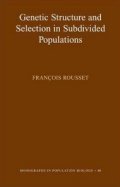
|
|
Consanguinity, Inbreeding, and Genetic Drift in ItalyLuigi Luca Cavalli-Sforza, Antonio Moroni, & Gianna Zei
Monographs In Population Biology, Vol. 39
Princeton University Press
2004
"In 1951, the geneticist Luigi Luca Cavalli-Sforza was teaching in Parma when a student - a priest named Antonio Moroni - told him about rich church records of demography and marriages between relatives. After convincing the Church to open its records, Cavalli-Sforza, Moroni, and Gianna Zei embarked on a landmark study that would last fifty years and cover all of Italy. This book assembles and analyzes the team's research for the first time. Using blood testing as well as church records, the team investigated the frequency of consanguineous marriages and its use for estimating inbreeding and studying the relations between inbreeding and drift. They tested the importance of random genetic drift by studying population structure through demography of the last three centuries, using it to predict the spatial variation of frequencies of genetic markers. The authors find that drift-related genetic variation, including its stabilization by migration, is best predicted by computer simulation. They also analyze the usefulness and limits of the concept of deme for defining Mendelian populations. The genetic effect of consanguineous marriage on recessive genetic diseases and for the detection of dominance in metric characters are also studied. Ultimately bringing together the many strands of their massive project, Cavalli-Sforza, Moroni, and Zei are able to map genetic drift in all of Italy's approximately 8,000 communes and to demonstrate the relationship between each locality's drift and various ecological and demographic factors. In terms of both methods and findings, their accomplishment is tremendously important for understanding human social structure and the genetic effects of drift and inbreeding."
|
Buy from amazon.co.uk 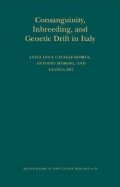
|
|
Geographical GeneticsBryan K. Epperson
Monographs In Population Biology, Vol. 38
Princeton University Press
2003
"Population genetics has made great strides in applying statistical analysis and mathematical modeling to understand how genes mutate and spread through populations over time. But real populations also live in space. Streams, mountains, and other geographic features often divide populations, limit migration, or otherwise influence gene flow. This book rigorously examines the processes that determine geographic patterns of genetic variation, providing a comprehensive guide to their study and interpretation. Geographical Genetics has a unique focus on the mathematical relationships of spatial statistical measures of patterns to stochastic processes. It also develops the probability and distribution theory of various spatial statistics for analysis of population genetic data, detailing exact methods for using various spatial features to make precise inferences about migration, natural selection, and other dynamic forces. The book also reviews the experimental literature on the types of spatial patterns of genetic variation found within and among populations. And it makes an unprecedented strong connection between observed measures of spatial patterns and those predicted theoretically. Along the way, it introduces readers to the mathematics of spatial statistics, applications to specific population genetic systems, and the relationship between the mathematics of space-time processes and the formal theory of geographical genetics."
|
Buy from amazon.co.uk 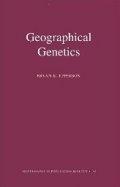
|
|
Niche Construction: The Neglected Process in EvolutionF. John Odling-Smee, Kevin N. Laland, & Marcus W. Feldman
Monographs In Population Biology, Vol. 37
Princeton University Press
2003
"The seemingly innocent observation that the activities of organisms bring about changes in environments is so obvious that it seems an unlikely focus for a new line of thinking about evolution. Yet niche construction - as this process of organism-driven environmental modification is known - has hidden complexities. By transforming biotic and abiotic sources of natural selection in external environments, niche construction generates feedback in evolution on a scale hitherto underestimated - and in a manner that transforms the evolutionary dynamic. It also plays a critical role in ecology, supporting ecosystem engineering and influencing the flow of energy and nutrients through ecosystems. Despite this, niche construction has been given short shrift in theoretical biology, in part because it cannot be fully understood within the framework of standard evolutionary theory. Wedding evolution and ecology, this book extends evolutionary theory by formally including niche construction and ecological inheritance as additional evolutionary processes. The authors support their historic move with empirical data, theoretical population genetics, and conceptual models. They also describe new research methods capable of testing the theory. They demonstrate how their theory can resolve long-standing problems in ecology, particularly by advancing the sorely needed synthesis of ecology and evolution, and how it offers an evolutionary basis for the human sciences. Already hailed as a pioneering work by some of the world's most influential biologists, this is a rare, potentially field-changing contribution to the biological sciences."
|
Buy from amazon.co.uk 
|
|
Consumer-Resource DynamicsWilliam W. Murdoch, Cheryl J. Briggs, & Roger M. Nisbet
Monographs In Population Biology, Vol. 36
Princeton University Press
2003
"Despite often violent fluctuations in nature, species extinction is rare. California red scale, a potentially devastating pest of citrus, has been suppressed for fifty years in California to extremely low yet stable densities by its controlling parasitoid. Some larch budmoth populations undergo extreme cycles; others never cycle. In Consumer-Resource Dynamics, William Murdoch, Cherie Briggs, and Roger Nisbet use these and numerous other biological examples to lay the groundwork for a unifying theory applicable to predator-prey, parasitoid-host, and other consumer-resource interactions. Throughout, the focus is on how the properties of real organisms affect population dynamics. The core of the book synthesizes and extends the authors' own models involving insect parasitoids and their hosts, and explores in depth how consumer species compete for a dynamic resource. The emerging general consumer-resource theory accounts for how consumers respond to differences among individuals in the resource population. From here the authors move to other models of consumer-resource dynamics and population dynamics in general. Consideration of empirical examples, key concepts, and a necessary review of simple models is followed by examination of spatial processes affecting dynamics, and of implications for biological control of pest organisms. The book establishes the coherence and broad applicability of consumer-resource theory and connects it to single-species dynamics. It closes by stressing the theory's value as a hierarchy of models that allows both generality and testability in the field."
|
Buy from amazon.co.uk 
|
|
Complex Population Dynamics: A Theoretical/Empirical Synthesis Peter Turchin
Monographs In Population Biology, Vol. 35
Princeton University Press
2003
"Why do organisms become extremely abundant one year and then seem to disappear a few years later? Why do population outbreaks in particular species happen more or less regularly in certain locations, but only irregularly (or never at all) in other locations? Complex population dynamics have fascinated biologists for decades. By bringing together mathematical models, statistical analyses, and field experiments, this book offers a comprehensive new synthesis of the theory of population oscillations. Peter Turchin first reviews the conceptual tools that ecologists use to investigate population oscillations, introducing population modeling and the statistical analysis of time series data. He then provides an in-depth discussion of several case studies - including the larch budmoth, southern pine beetle, red grouse, voles and lemmings, snowshoe hare, and ungulates - to develop a new analysis of the mechanisms that drive population oscillations in nature. Through such work, the author argues, ecologists can develop general laws of population dynamics that will help turn ecology into a truly quantitative and predictive science. Complex Population Dynamics integrates theoretical and empirical studies into a major new synthesis of current knowledge about population dynamics. It is also a pioneering work that sets the course for ecology's future as a predictive science."
|
Buy from amazon.co.uk 
|
|
Communities and Ecosystems: Linking the Aboveground and Belowground ComponentsDavid A. Wardle
Monographs In Population Biology, Vol. 34
Princeton University Press
2002
"Most of the earth's terrestrial species live in the soil. These organisms, which include many thousands of species of fungi and nematodes, shape aboveground plant and animal life as well as our climate and atmosphere. Indeed, all terrestrial ecosystems consist of interdependent aboveground and belowground compartments. Despite this, aboveground and belowground ecology have been conducted largely in isolation. This book represents the first major synthesis to focus explicitly on the connections between aboveground and belowground subsystems - and their importance for community structure and ecosystem functioning. David Wardle integrates a vast body of literature from numerous fields - including population ecology, ecosystem ecology, ecophysiology, ecological theory, soil science, and global-change biology - to explain the key conceptual issues relating to how aboveground and belowground communities affect one another and the processes that each component carries out. He then applies these concepts to a host of critical questions, including the regulation and function of biodiversity as well as the consequences of human-induced global change in the form of biological invasions, extinctions, atmospheric carbon-dioxide enrichment, nitrogen deposition, land-use change, and global warming. Through ambitious theoretical synthesis and a tremendous range of examples, Wardle shows that the key biotic drivers of community and ecosystem properties involve linkages between aboveground and belowground food webs, biotic interaction, the spatial and temporal dynamics of component organisms, and, ultimately, the ecophysiological traits of those organisms that emerge as ecological drivers. His conclusions will propel theoretical and empirical work throughout ecology."
|
Buy from amazon.co.uk 
|
|
The Functional Consequences of Biodiversity: Empirical Progress and Theoretical Extensions Editor: Ann P. Kinzig, Stephen Pacala, & G. David Tilman
Monographs In Population Biology, Vol. 33
Princeton University Press
2002
"Does biodiversity influence how ecosystems function? Might diversity loss affect the ability of ecosystems to deliver services of benefit to humankind? Ecosystems provide food, fuel, fiber, and drinkable water, regulate local and regional climate, and recycle needed nutrients, among other things. An ecosyste's ability to sustain functioning may depend on the number of species residing in the ecosystem - its biological diversity - but this has been a controversial hypothesis. There are many unanswered questions about how and why changes in biodiversity could alter ecosystem functioning. This volume, written by top researchers, synthesizes empirical studies on the relationship between biodiversity and ecosystem functioning and extends that knowledge using a novel and coordinated set of models and theoretical approaches. These experimental and theoretical analyses demonstrate that functioning usually increases with biodiversity, but also reveals when and under what circumstances other relationships between biodiversity and ecosystem functioning might occur. It also accounts for apparent changes in diversity-functioning relationships that emerge over time in disturbed ecosystems, thereby addressing a major controversy in the field. The volume concludes with a blueprint for moving beyond small-scale studies to regional ones - a move of enormous significance for policy and conservation but one that will entail tackling some of the most fundamental challenges in ecology."
|
Buy from amazon.co.uk 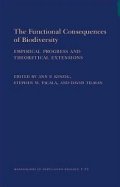
|
|
The Unified Neutral Theory of Biodiversity and BiogeographyStephen P. Hubbell
Monographs In Population Biology, Vol. 32
Princeton University Press
2001
"Despite its supreme importance and the threat of its global crash, biodiversity remains poorly understood both empirically and theoretically. This ambitious book presents a new, general neutral theory to explain the origin, maintenance, and loss of biodiversity in a biogeographic context. Until now biogeography (the study of the geographic distribution of species) and biodiversity (the study of species richness and relative species abundance) have had largely disjunct intellectual histories. In this book, Stephen Hubbell develops a formal mathematical theory that unifies these two fields. When a speciation process is incorporated into Robert H. MacArthur and Edward O. Wilson's now classical theory of island biogeography, the generalized theory predicts the existence of a universal, dimensionless biodiversity number. In the theory, this fundamental biodiversity number, together with the migration or dispersal rate, completely determines the steady-state distribution of species richness and relative species abundance on local to large geographic spatial scales and short-term to evolutionary time scales. Although neutral, Hubbell's theory is nevertheless able to generate many nonobvious, testable, and remarkably accurate quantitative predictions about biodiversity and biogeography. In many ways Hubbell's theory is the ecological analog to the neutral theory of genetic drift in genetics. The unified neutral theory of biogeography and biodiversity should stimulate research in new theoretical and empirical directions by ecologists, evolutionary biologists, and biogeographers."
|
Buy from amazon.co.uk 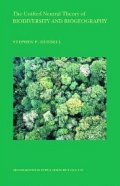
|
|
Stability in Model PopulationsLaurence D. Mueller & Amitabh Joshi
Monographs In Population Biology, Vol. 31
Princeton University Press
2000
"Throughout the twentieth century, biologists investigated the mechanisms that stabilize biological populations, populations which - if unchecked by such agencies as competition and predation - should grow geometrically. How is order in nature maintained in the face of the seemingly disorderly struggle for existence? In this book, Laurence Mueller and Amitabh Joshi examine current theories of population stability and show how recent laboratory research on model populations - particularly blowflies, Tribolium, and Drosophila - contributes to our understanding of population dynamics and the evolution of stability. The authors review the general theory of population stability and critically analyze techniques for inferring whether a given population is in balance or not. They then show how rigorous empirical research can reveal both the proximal causes of stability (how populations are regulated and maintained at an equilibrium, including the relative roles of biotic and abiotic factors) and its ultimate, mostly evolutionary causes. In the process, they describe experimental studies on model systems that address the effects of age-structure, inbreeding, resource levels, and population structure on the stability and persistence of populations. The discussion incorporates the authors' own findings on the evolution of population stability in Drosophila. They go on to relate laboratory work to studies of animals in the wild and to develop a general framework for relating the life history and ecology of a species to its population dynamics. This accessible, finely written illustration of how carefully designed experiments can improve theory will have tremendous value for all ecologists and evolutionary biologists."
|
Buy from amazon.co.uk 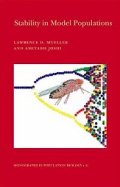
|
|